
We somehow missed the release of the Malekko Goatkeeper last year (probably because the company didn’t send the pedal to any of the YouTubers we follow!) so we need to send a YUGE thank you to Dennis Kayzer for posting a video of it on his channel, because this is a rather unique pedal.
Presented as a 2-Stage Polyrhythmic Analog Tremolo, the Goatkeeper is a redesigned version of the Lightfoot Labs pedal by the same name, first released back in 2007. The circuit features two tremolos that can interact with each other creating textures that go beyond the classic oscillating LFO waves.
The two LFOs can interact in four different ways:
Single Mode: First stage only for classic tremolo.
Sequential Mode: The two stages are run one after the other, alternating tremolo settings
Composite Mode: The two stages are run simultaneously and the effective waveform is a polyrhythmic composite of the two.
Modulation Mode: The two stages are run simultaneously and the second waveform modulates the first waveform.
While the Rate knob is shared (and can be set via external tap tempo), two 12-Position Multiplier Controls let you chose the speed of each side’s oscillation (whole note, half note, quarter note, etc).
Wave knobs
The least intuitive knobs are the two labeled “W1″ and W2” ones on the bottom left and right. “W” stands for “wave,” and their main function is to select the shape of the LFO for each tremolo circuit. But they also select the mode functionality.
Both sides offer the following LFO shapes: SINE, SAW, RAMP, SQUARE, and PULSE.
The W1 Modes are:
SEQUENTIAL: alternates W1 with W2.
RANDOM (R): random SEQ or SIMUL waveform.
SIMULTANEOUS: W1 modified by W2 (aka Modulation mod).
The W2 Modes are:
COMPOSITE: adds waveform to W1 waveform.
SINGLE (>>): this removes W2 from signal.
MODULATION: modulates W1 output.
We couldn’t understand from the manual what happens when two modes are selected from each of the knobs, so we sent an email to the Malekko folks – stay tuned for the answer.
But whatever the answer might be, this is obviously a very interesting device that’s bound to inspire textural and creative guitarists.
The Malekko Goatkeeper (MGK) is a completely redesigned version of the Lightfoot Labs Goatkeeper, first released in 2007. The core of the pedal is an all analog tremolo circuit using a THAT Corp VCA, which when combined with the built in waveforms, can produce tremolo sounds from percussive to smooth. The MGK’s LFO generation consists of two stages, each with a range of multiplier values and waveform selection.
The Malekko Goatkeeper (MGK) is a completely redesigned version of the Lightfoot Labs Goatkeeper, first released in 2007. The core of the pedal is an all analog tremolo circuit using a THAT Corp VCA, which when combined with the built in waveforms, can produce tremolo sounds from percussive to smooth. The MGK’s LFO generation consists of two stages, each with a range of multiplier values and waveform selection.
The two stages can be run in one of four modes:
Sequential: The two stages are run one after the other
Composite: The two stages are run simultaneously and the effective waveform is a polyrhythmic composite of the two.
Modulation: The two stages are run simultaneously and the second waveform modulates the first waveform.
Single: First stage only for classic tremolo.Tempo can be set with the RATE knob or with the Tap/Sync input. The Tap/Sync input accepts a Malekko Lil’ Buddy for tap tempo control, or an analog clock/metronome signal. The DEPTH knob allows the effect to vary from subtle to high intensity.






















